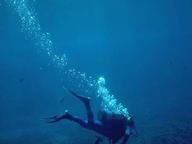Quiz Answer Key and Fun Facts
1. Before I get into my story, I have to admit that I always thought that SCUBA was a word, maybe named after some guy who invented it! I wasn't sure whether to believe my friend John when he told me that SCUBA is actually an acronym that stands for "Self-Contained Underwater Breathing Articles". Is he right?
2. My friend John and I decided that it would be a great idea to travel the world to experience all the best dive spots. We thought that we'd start out by seeing what other divers had to say on the subject. So, we looked up a SCUBA travel website that had a top ten list of diving sites around the world, based on reader voting. Decision made, we began planning out trip to see 'The Yongala'. Do you know what that is?
3. Having settled on our destination, we still faced a rather large obstacle before getting on the plane; we needed to learn how to SCUBA dive! I asked John to do the legwork and come up with some options for taking lessons. A little while later he presented a list of companies that could train us and certify us as SCUBA ready. Which of these was NOT on that list?
4. John and I signed up for a beginner's SCUBA class called 'Open Water Diving' and proceeded to get a crash course in all the SCUBA basics. We learned about the equipment, about how buoyancy works, and about the effects that pressure has on our bodies as we go deep and also when we ascend from the deep. They said that if you come up from deep water too quickly, it's possible to suffer from something called 'decompression sickness', or 'diver's disease'. What's that other name for it, the one that starts with a 'b' and is just one word?
5. We finally got into the pool, and got to gear up with all the necessities for doing a basic dive. I was most concerned with making sure that I had all the pieces needed to be able to breathe! Which of these pieces is not part of the breathing apparatus?
6. After completing the classroom stuff and the basics in the pool (confined water dives), it was time for us to do our first open water dive. As we prepped our equipment, I asked our instructor if there would be a buoy of some kind to mark our diving area. He explained that the SMB (surface marker buoy) was typically only used during drift dives, night dives, misty conditions, or in disturbed sea conditions, although he was quick to say that there was no standardized rule. He then showed us the buoy. It was inflatable, and showed a flag when fully inflated. What did the flag look like?
7. Our first open water dive! John and I went out with our instructor, and as we got ready to descend, we went through our buddy check. Satisfied we'd done it right, we inflated each other's BCD and then stood and jumped into the water from the boat's diving platform. Which of the four standard water entries was that?
8. Once we got going, we dove down a ways, and I couldn't help but turn to John and give him a fist pump of victory at our awesome accomplishment! To my surprise, the instructor came swimming over and grabbed my SPG, looking at it in alarm. Then he looked at me with a puzzled look. What had I inadvertently signalled?
9. It took another couple of dives, but we finally passed our certification! After John and I shook our instructor's hand, we decided to go out for a bit on our own. We had some fun chasing the fish around, and examining some debris at the bottom of the lake, and then I was ready to go home. I signaled to John that I was ready to ascend. How did I do that?
10. Finally, SPRING BREAK! John and I headed off on our adventure to dive at 'The Yongala'. After a couple of days diving at the incredible site, we decided that we were ready to take on the another level of diving certification. Thinking of the possibility of caverns and under-ice diving, what course did we sign up for?
Source: Author
reedy
This quiz was reviewed by FunTrivia editor
WesleyCrusher before going online.
Any errors found in FunTrivia content are routinely corrected through our feedback system.
